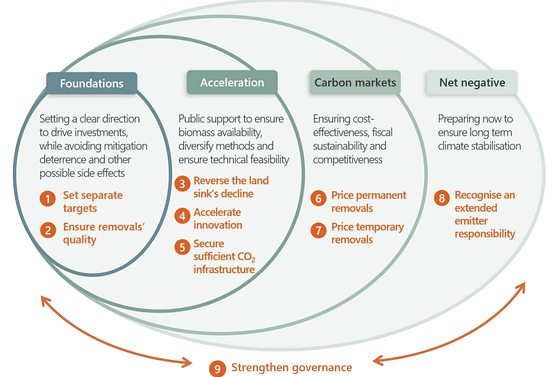In the recently published report ‘Scaling Up Carbon Dioxide Removals - Recommendations for Navigating Opportunities and Risks in the EU’, the European Scientific Advisory Board on Climate Change has laid down nine recommendations to enable the EU to incorporate carbon dioxide removals into its policy-making landscape and facilitate the EU’s achievement of net-zero greenhouse gas emissions by 2050 and net-negative greenhouse gas emissions after 2050:
- Set different legally binding goals for emission reductions, permanent and temporary removals;
- Introduce adequate monitoring, reporting and verification (MRV) systems targeting CDR activities;
- Take immediate actions to enhance the conditions of the EU’s land sink;
- Resolve ambiguities regarding future CDR regulation and reinforce existing regulations so as to unify rules regarding funding to scale-up CDR innovation and facilitate access to different financing tools;
- Take steps to enable EU members states to take coordinated action, increase the level of CDR investments and ameliorate preparation for bolstering the capacity of the EU to create an infrastructure for transferring and storing CO2;
- Integrate permanent removals into the EU Emission Trading Scheme in a gradual manner by setting prices for them while taking precautions to prevent mitigation deterrence, taking into account the environmental hazards that are at stake, ensuring distributional equity and reducing costs to the greatest extent possible;
- Establish new frameworks to ensure that the stakeholders that engage in emitting activities in the Land Use, Land-Use Change and Forestry (LULUCF) sector are required to make payments while other stakeholders that engage in removals are provided with financial incentives;
- Introduce a liability scheme so as to hold those that contribute to current emissions responsible for removing such emissions in the future;
- Strengthen the governance capacity of the EU so as to enable it to adequately manage various CDR-related issues such as ‘tracking, certification, innovation, infrastructure and pricing’;
To read the report, visit:
